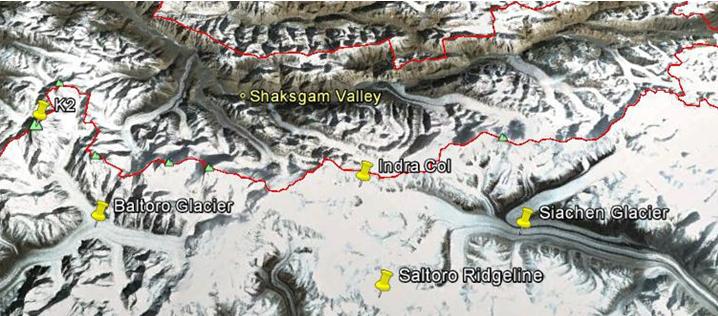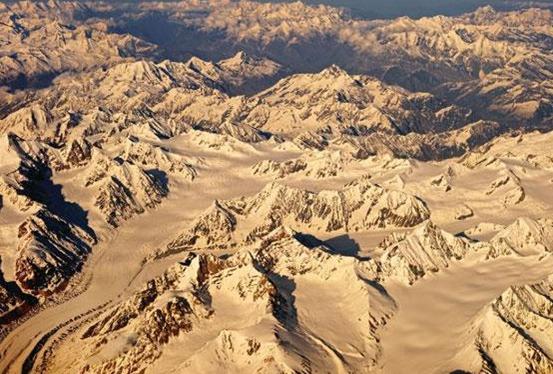Siachen:The Geopolitics and Strategy in Frozen Battlefield by Shahzad Masood Roomi…
Aftermath of Gyari Tragedy:
The tragic incident of 7th April avalanche that hit the battalion HQ of 6NLI battalion of Pakistan Army in Gyari sector of Siachen trapping 139 Pakistani troops and civilians has traumatized the entire nation. Pakistan Army is desperately trying to reach the trapped persons under the 80 feet high and one square kilometer wide pile of rubble, rock, snow and ice in a rescue operation in an unforgiving weather and constant snow falling at a height of 14000 feet from sea level. The incident was the worst catastrophe since 1984 when India illegally occupied Siachen glacier and Saltoro ridge to its southwest.
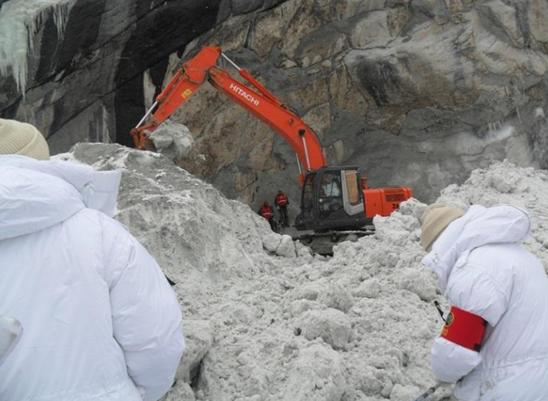 After this dreadful tragedy, a very shocking and sordid trend emerged in certain media circles within Pakistan, like SAFMA, demanding withdrawal of forces from Siachen. On 9th April 2012, two days after the awful tragedy, SAFMA head Imtiaz Alam stated,
After this dreadful tragedy, a very shocking and sordid trend emerged in certain media circles within Pakistan, like SAFMA, demanding withdrawal of forces from Siachen. On 9th April 2012, two days after the awful tragedy, SAFMA head Imtiaz Alam stated,
―Why should we be going for an agreement? We should just withdraw. If we do that, Indian domestic pressure will also result in a withdrawal there. They will say it is madness to continue.‖[11]
Without giving proper knowledge of background of the incident and history of conflict on world‟s highest battlefield these self-claimed peace preachers began to tell the Pakistanis that it is time to bring our boys home unilaterally because Siachen glacier is melting due to presence of forces there and this deployment of force is futile. Apart from the compromised media elements, the political leadership also failed to show solidarity with the defenders of Pakistan immediately after the incident. The entire nation is on the brink of complete internal chaos and Pakistan Army has been caught in a ruthless and cut-throat battle against the religious and secular terrorists and separatists in ongoing massive 4GW
and needs the backing and support of every nook and corner of the country. But unfortunately, the regime in Islamabad remained busy in its survival exercise in Supreme Court isolating itself from every important national security and governance issue like the awful tragedy at Gyari sector. President of Pakistan failed to cancel or even postpone his private trip to India, the country which had put Pakistani troops in this treacherous battlefield in the first place. Parliament is keen to investigate the incident rather than doing anything for the families of heroes of Pakistan Army who gave the ultimate sacrifice. But most disgusting remarks came from the leader of Pakistan‟s second biggest political party PML(N) and former PM Nawaz Sharif who, just like SAFMA, asked Pakistan army to withdraw from the battlefront unilaterally as the solution while the enemy
has already 1000 square miles (2600 square kilometer) of Pakistani territory under the occupation of enemy who has plans to capture more in order to complete the strategic goal of cutting off Pakistan from China.
For years, Indians have demanded that Pakistan accept the current deployment of forces along the ridge line (known as Actual Ground Position Line or AGPL) of Saltoro range as permanent border which means accepting the illegal occupation of the glacier by the Indian Army. In this backdrop, the proposal of withdrawing unilaterally is not only completely delusional but is impossible to act upon due to the strategic importance of the region and Indian expansionist designs which turned this glacier into the battlefield. A detailed historical and strategic analysis of Indian policy making regarding this subtle and critical issue is necessary to understand that why Pakistan cannot withdraw from the glacier in unilateral fashion.
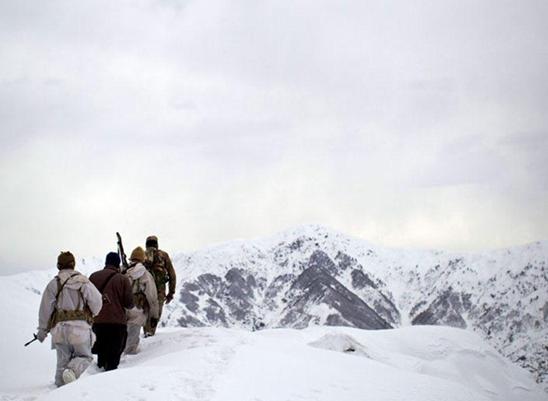 Pakistan Army patrolling party:
Pakistan Army patrolling party:
There is number of reasons, from financial to environmental, for both the countries to withdraw from this front, even in the presence of core issue of Kashmir. 1989 agreement between both the sides demands the relocation of forces to the positions away from the glacier but not unilaterally. So, anyone who is advising this as solution is either too naive to understand the gravity of the
situation or is deliberately part of something more sinister against Pakistan and its core strategic interests.
History of conflict:
Ostensibly, the Siachen crisis, just like Kashmir, is the result of uncompleted border demarcation between the two nations but expansionist designs of India are the core reason behind this problem. This is why India is reluctant to implement the 1989 agreement. Historically, Siachen belongs to Pakistan; all of it. All the international climbing and mountaineering expedition teams to climb K2 and other mountains, always got their NoCs from the Pakistani governments.
After the initial expedition of Imperial College London in 1957, Austrian and German teams came to Pakistan in 1961, 1962, 1976 and 1978 all got permission from Islamabad to visit the area. Overall, there were 16 major expeditions which went to Siachen and beyond from 1974 to 1981. 11 of these were from Japan, three from Austria, and one each from Britain and the United States. Being international expeditions, these were known to the entire world including India.
This clearly proves that this area belongs to Pakistan and Indian military presence in the area is no more than an act of war and overt aggression which by default legitimates retaliatory actions from Pakistan.
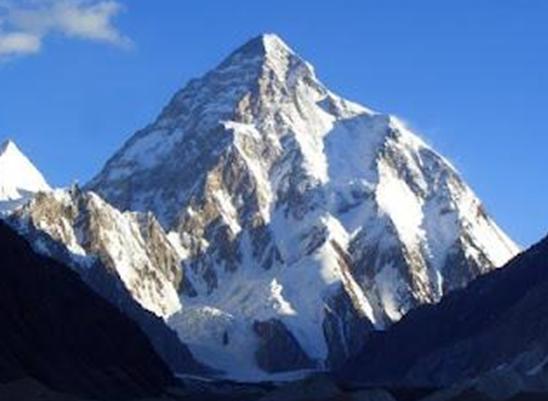 K-2 , A diamond of ice – An ultimate challenge for world mountaineers:
K-2 , A diamond of ice – An ultimate challenge for world mountaineers:
Apart from this, Siachen has been shown as part of Pakistan in many of international world atlases like UN Defense Mapping Agency (DMA), Historical Atlas of South Asia by Chicago University, Britannica Atlas, National Geographic Society of World Atlas and Times World Atlas.
The root of Pakistani claim, apart from afore mentioned published maps by international bodies, stems from the Karachi Agreement, signed under UN auspices, in 1949 which states that from the last demarcated point, Khor (Grid Reference NJ9842), the line would run „thence North to the glaciers‟ [2] and this is what all international publishers (including Indian) did. They extended the line towards North which connects NJ9842 to Karakoram Pass.
Sir Oven Dixon was appointed as first UN observer over Kashmir between Pakistan and India. He mentioned Siachen as part of Pakistan‟s Northern Areas (current Gilgat-Batistan) and it was further endorsed by the Indian writer P.L. Lakhanpal in his book “Essential Documents and Notes on the Kashmir Dispute”. Indian defense analyst Ravi Rikhye in his work “The Fourth round: Indo-Pak war” included many maps of LoC and according to these maps Siachen is Pakistani territory. Lt. Gen K.P. Candeth, retired from Indian army in 1984, he wrote his book “The Western Front: Indo Pakistan war 1971”. The maps included in his book also showed NJ-9842 and Siachen as part of Pakistan.
The Indian claim is that the line should follow the ridgeline of the Saltoro Range which actually runs in a North Westerly direction instead of going to North as stated in 1949 Karachi Agreement. Indians claimed that this is universally applicable watershed principle for settling border disputes. But this should have been mentioned in the agreement between the two parties which was not there in Karachi agreement or even in the 1989 agreement hence Pakistan has legitimate claim over the Siachen glacier and Saltoro Range.
Now, looking at the map of the LoC and Siachen and extending the line towards North, as stated in the 1949 agreement, clearly suggests that not only the glacier but also the two heighest passes (Sia La, Bilafond La) belongs to Pakistan. The battle zone comprised an inverted triangle resting on NJ 9842 with Indira Col and the Karakoram pass as the other two extremities.
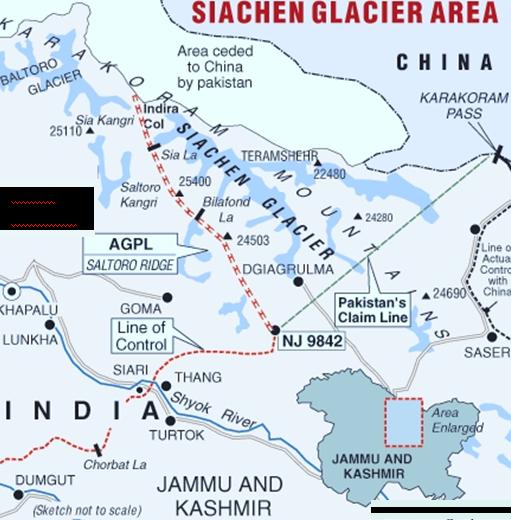 The Conflict Zone:
The Conflict Zone:
Indian Occupation of Siachen:
There is a general perception that it was April 1984 when Indians launched the Operation Megdhoot and captured three important passes in impassable Saltoro range at height of more than 18,000 feet from sea level. But in reality Indian Army began planning, way back in 1978, to capture the passes connecting Siachen glacier to Pakistan‟s Gilgal-Baltistan areas and capture the KKH to sever Pakistan‟s road links to China.
Lt. Gen. M. L. Chibber, under whose command Operation Meghdoot was launched, confessed in his article “Siachen – An Untold Story. A personal account” published in Indian Defense Weekly Jan 1990 that it was 1978 when Indian army‟s Western Command started planning of this operation. In his own words, general was worried that US tourism department map showed Siachen as part of Pakistan. ―In 1978, when I was DMO, we got information about a foreign expedition from the Pakistan side visiting the Siachen Glacier. The Line of Control terminates at NJ9842. The Glaciers are not demarcated. We sent a patrol next year and it was confirmed that Japanese expeditions has visited the Siachen Glacier. So routine patrolling started. This should give the readers a real background of what happened in 1982-83. It will show that India did not act unilaterally.‖ [3]
Here the former commander of Northern Command of Indian Army didn’t bother to mention the reasons that why Indian Army never raised the issue with Pakistani Army or government regarding the mountaineering expeditions going to Siachen from Pakistani side prior to 1984? As explained earlier that such mountaineering expeditions had been going to the region since late 1950‟s and foreign teams were reaching Pakistan on international visas and there were no signs of any kind of discomfort from Indian side. This patent fact torpedoes the entire rationale of illegal Indian occupation but it must not be surprising for Pakistanis as nothing else can be expected from the Indian Army and policymakers who has been trained with Chankiya’s Earth-Shaster as primer strategic military and political guide.
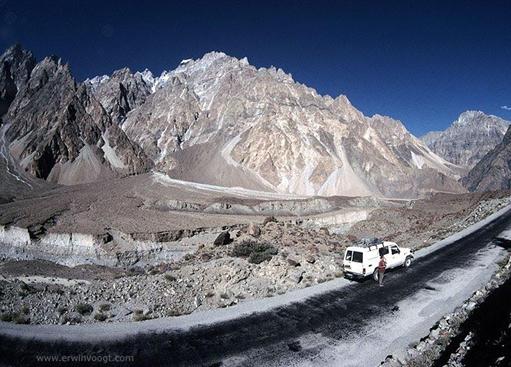 Korakaram Highway – the ultimate Indian Army objective:
Korakaram Highway – the ultimate Indian Army objective:
In another account Gen. Chibber gave the following details of Indian rationale for occupying the Siachen. ―The problem precipitated on 21st August 1983 when a protest note from Northern Sector Commander of Pakistan was handed over to his counterpart in Kargil stating that Line of Control joins with the Karakoram Pass, also that all the area West of this extended line belongs to Pakistan. When Army Headquarters saw this and also got information that Pakistan troops had occupied Bilafond Pass, they ordered Northern Command to prevent the occupation of the
Glacier area by Pakistan during the mountaineering season in 1984.‖ [4]
Again, he didn’t bother to tell why the protest from Pakistani side was launched in the first place? Reality is that a protest was launched when a SSG Company, during a routine reconnaissance mission, discovered the presence of a camp of Ladakh Scouts on Bilafonda La pass, in 1983. This exposes the lies of former chief of Indian Army‟s Northern Command that Pakistan army occupied the pass. Had Pakistan Army captured the pass in 1983, as claimed by LM Chibber, Indians would have never been able to put their feet on the glacier.
Col. Narendra Kumar “bull” is credited by India for the “historic victory” over Saltoro ridgeline in Operation Maghdoot during April 1984. Actually he was the one who initiated the war on the glacier and turned it into the world‟s highest battlefield. The accounts of his patrols, since 1978 to 1983, are more revealing about Indian aggression and illegal occupation. ―We found labels from tin cans and cigarette packs with Pakistani names, German and Japanese equipment. It was this that convinced the government of India that Pakistan was going where it should not have been.‖ [5]
No such evidence was ever shown to anybody in the world. What Kumar found on the glacier was normal garbage stuff which any mountaineering team would leave behind. But more interestingly, he never found a human on the Siachen which actually is enough to destroy the entire Indian propaganda that it was Pakistan Army who militarized the glacier. ―There wasn’t a soul there. There was so much to climb—so many uncharted high peaks! And those pinnacles—rock pinnacles going straight up! And small glacial streams—so blue and so cold! The view from Sia Kangri looking down on the Siachen was such a beautiful sight. Just like a great white snake… going, going, going. I have never seen anything so white and so wide.‖ [6]
Actually, this entire climbing of the glacier was the first step to capture the entire region where many other important glaciers are also located and doing so would have enabled India to cut Pakistan‟s access to China through KKH. Indians have cut Pakistani access to Karakoram Pass, already, by occupying Siachen. This is the core strategic reason why Indian does not want to leave the area despite suffering a casualty every second day due to harsh weather conditions and unforgiving terrain.
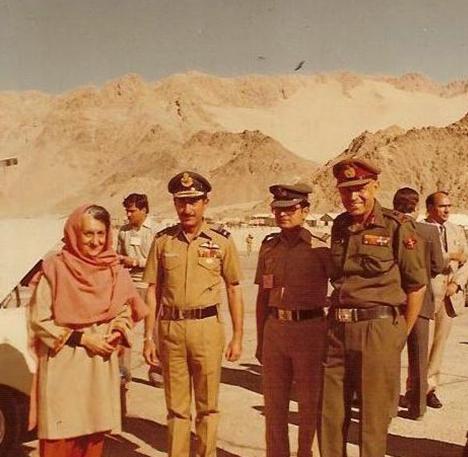 Indira Gandhi with Lt. Gen LM Chibber and Indian Air Chief in Laddakh , 1983. Furthermore, it remains an interesting “coincident” in the history that during 1981-82 Indian sent teams to Antarctica to study the arctic weather there. Interestingly, other than Siachen glacier there is no arctic region controlled and occupied by India but still Prime Minister Indira Gandhi
Indira Gandhi with Lt. Gen LM Chibber and Indian Air Chief in Laddakh , 1983. Furthermore, it remains an interesting “coincident” in the history that during 1981-82 Indian sent teams to Antarctica to study the arctic weather there. Interestingly, other than Siachen glacier there is no arctic region controlled and occupied by India but still Prime Minister Indira Gandhi
took a personal interest in the expedition, calling it the ”fulfillment of a lifelong dream.” [7]
Pakistani response:
Pakistan Army and ISI were busy in thwarting Soviet onslaught on Afghanistan in order to secure the Western front, so Indian aggression on Siachen remained unnoticed for first three to four year. It was only in 1982 When Pakistan Army realized that Indians are not only moving in but are also consolidating their military infrastructure on the glacier in order to move further towards North and Northwest in order to cut KKH and entire GB. Pakistan sent first military team on a reconnaissance mission in the area in 1983.
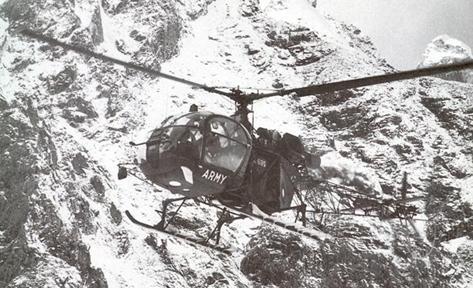 General (retired) Jahandad Khan, of Pakistan Army, has noted, in his accounts, about the first visit by SSG to the Bilafond La pass in 1983, 5 years after Indian Army Col. Kumar began his illegal patrols in the Pakistani areas to survey the area for later assault by Indian Army brigade in 1984. ―When the SSG company got across Bilafond Pass (in 1983), the helicopter pilot reported an Indian location one thousand yards ahead in the Siachen Area. After seeing our helicopter, the Indian troops, comprising Ladakh Scouts, left their location in a great hurry abandoning all their rations and tentage. The SSG Company stayed in this area for ten days but was ordered to withdraw in the first week of September 1983 as it had started snowing and the company did not have equipment for survival in the winter season under thirty to forty feet of snow, which is the normal snow range.
General (retired) Jahandad Khan, of Pakistan Army, has noted, in his accounts, about the first visit by SSG to the Bilafond La pass in 1983, 5 years after Indian Army Col. Kumar began his illegal patrols in the Pakistani areas to survey the area for later assault by Indian Army brigade in 1984. ―When the SSG company got across Bilafond Pass (in 1983), the helicopter pilot reported an Indian location one thousand yards ahead in the Siachen Area. After seeing our helicopter, the Indian troops, comprising Ladakh Scouts, left their location in a great hurry abandoning all their rations and tentage. The SSG Company stayed in this area for ten days but was ordered to withdraw in the first week of September 1983 as it had started snowing and the company did not have equipment for survival in the winter season under thirty to forty feet of snow, which is the normal snow range.
Former chairman of PoF Wah Lt. Gen (retired) Abdul Qayyum was one of the members of this trip as well. He recalls his visit to the area in 1983 in following words. ―When in early 1980, then DMO Brigadier (promoted to General later) Ghulam M Malik, Commander SSG Brig. T.M. Shaheed and me landed on Siachen glacier via helicopter we witnessed an abandoned camp of Ladakh Scouts. We found an official paper which confirmed that the officer of Ladakh scouts was a major of Indian Army. He brought a mountaineer expedition with him but after our arrival they left the camp.‖ [8]
Indians claim that Operation Maghdoot was pre-empted to prevent the planned Pakistani occupation of the area but events transpired after 1984 further exposed that Indian designs were not limited to Siachen glacier but their real aim was (and still remains) to cut Pakistan‟s road link to China through Khunjrab pass in Karakoram Range. General (retired) Jahandad Khan has accounted that the real intelligence received by Pakistan Army was about Indian plans to capture the Baltoro ridgeline and glacier (second largest after Siachen with 64 KM length) occupying the region where K2 and other high KaraKoram peaks are
located.
The frozen battlefield:
This was also endorsed by the massive Indian attack, in 1989, to capture Chumik glacier to push Pakistani troops towards further Southwest. Due to timely response and unthinkable bravery of Captain Naveed (later promoted to Major) and sheer professionalism of Pakistan army aviation, Indian plans were thwarted and Pakistan Army secured the Chumik peak and established Naveed Post there. Later both the parties agreed to demilitarize the peak.
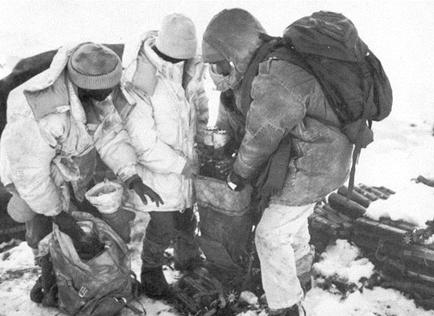 Pakistan Army Jawans – Carrying artillery shells in their backpacks, 1987
Pakistan Army Jawans – Carrying artillery shells in their backpacks, 1987
Pakistan army did make some daring attempts to dislodge the Indian occupying forces from the Bilafond La pass and the glacier. Attacks of 1987 and 1995 were significant. But Saltoro Range has proved to be the biggest challenge as this steep wall of ice, at some point, has 90 degree slope to climb for Pakistan Army before they could engage Indian forces entrenched on the peak tops.
Harsh weather conditions also proved murderous for the advancing parties reluctantly no significant change in position of both the armies occurred.
The Conflict – Present scenario:
The Indian Army controls a few of the top-most heights, holding on to the tactical advantage of high ground, however with the Pakistani forces in control of Baltoro and other glaciers and valleys in immediate West to Saltoro ridgeline, Indian access to K2 and other surrounding peaks has been blocked effectively and mountaineering expeditions to these peaks continue to go through with the approval of the Government of Pakistan. The situation is as such that Pakistanis cannot get up to the glacier, while the Indians cannot come down. Presently India holds entire 75 KM of Siachen glacier and commands two of the three passes including the highest motorable pass – Khardungla Pass.
 Pakistan Artillery in action – Making the lives of Indians more miserable! Pakistan controls Gyong La pass that overlooks the Shyok and Nubra river Valley and India`s access to Leh district. Logistically, Pakistan Army holds the advantage since its road-head is only 20 KM away from the farthest post while Siachen is a logistical nightmare for the Indian troops who are stationed about 80 km away from the road-head and their supplies have to be maintained entirely by air, which is not only cost prohibitive but also risky because of the adverse weather conditions most of the times. [9]
Pakistan Artillery in action – Making the lives of Indians more miserable! Pakistan controls Gyong La pass that overlooks the Shyok and Nubra river Valley and India`s access to Leh district. Logistically, Pakistan Army holds the advantage since its road-head is only 20 KM away from the farthest post while Siachen is a logistical nightmare for the Indian troops who are stationed about 80 km away from the road-head and their supplies have to be maintained entirely by air, which is not only cost prohibitive but also risky because of the adverse weather conditions most of the times. [9]
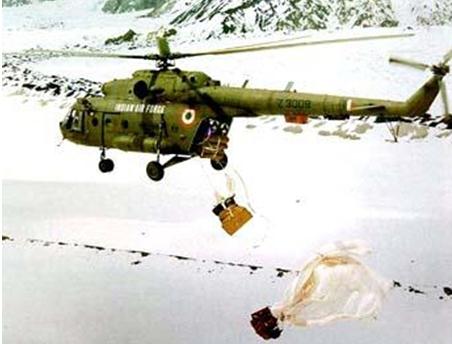 Siachen – Logistical nightmare of Indian Army. Apart from each other and an impassable terrain, snow-bound disease and weather conditions are the worst enemies for both the armies in this region. HAPE (High-Altitude Pulmonary Edema) and HACE (High-Altitude Cerebral Edema) have been proved ultimate killers above 18,000 feet. HAPE is a swift assassin. One can be dead within matter of hours suffering from HAPE which is an accumulation of fluid in the lungs. HACE doesn‟t kill immediately but anyone suffering from it experience severe swelling, headaches, hallucinations, and dementia due to leaks of fluid from oxygen-starved blood vessels in the brain, Untreated, HACE can kill a man within 24 hours. Needless to say, these high altitude assassins are excruciatingly painful. [10]
Siachen – Logistical nightmare of Indian Army. Apart from each other and an impassable terrain, snow-bound disease and weather conditions are the worst enemies for both the armies in this region. HAPE (High-Altitude Pulmonary Edema) and HACE (High-Altitude Cerebral Edema) have been proved ultimate killers above 18,000 feet. HAPE is a swift assassin. One can be dead within matter of hours suffering from HAPE which is an accumulation of fluid in the lungs. HACE doesn‟t kill immediately but anyone suffering from it experience severe swelling, headaches, hallucinations, and dementia due to leaks of fluid from oxygen-starved blood vessels in the brain, Untreated, HACE can kill a man within 24 hours. Needless to say, these high altitude assassins are excruciatingly painful. [10]
Saltoro Range – Killer heights:
Can Pakistan risk this strategic region for the sake of peace appeals by some Indian apologists in Pakistan? This is the core question and the only answer to that question is „Never!‟ Understanding the multipronged Indian strategy towards Pakistan is essential in order to comprehend the above answer. Right now, India is waging a covert war within Pakistan on following axis.
1. Supporting TTP and BLA, from Afghanistan, in order to thin-out Pakistan Army in an endless war against terrorism.
2. Economic intimidation of Pakistan and to destroy Pakistan’s food supply chain, through water aggression is relatively new but most ruthless move in this hushed war by India.
3. Backing and supporting the sub-nationalists and the separatist elements in Baluchsitan and Sindh.
4. Ideological subversion and information warfare. Psi-ops to spread despondency and provincial disharmony.
5. Military buildup across the Eastern border under the Pakistan specific Cold Start Doctrine (CSD).
6. Coercive diplomacy and lobbying in Washington to destroy Kashmiris struggle for the self-determination by linking it to global terrorism.
7. Trade liberalization in the presence of core issues like Kashmir. Extending economic and trade outreach to Afghanistan and Central Asia using Pakistani road links.
8. Forcing Pakistan to accept a back channel settlement of Kashmir issue which will be amenable to Indian interests only and would destroy the Pakistani case in UN.
This Indian strategy has been wreaking havoc in Pakistan since the beginning of war on terror. Siachen issue must be analyzed in this bigger and broader strategic context to completely comprehend the grand Indian designs to isolate and then decapitate Pakistan to become regional and then global player after competing with China.
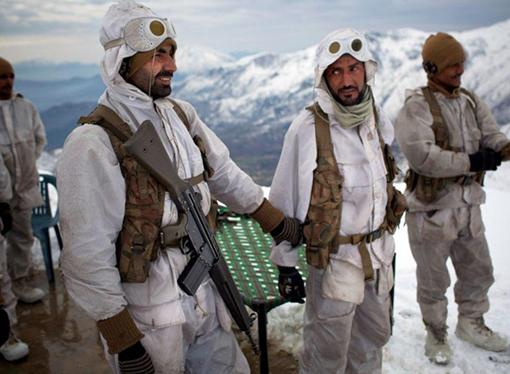 Pakistan Army Jawans at Saltoro ridge The perception that no one cares about the Siachen and other glaciers in the region is just a dangerous misjudgment. In reality this region holds strategic importance not only for India and Pakistan but for China as well. Retired Air-Vice Marshal, Shahzad Chudhary, has following to say in this regard. ―It remains the impassibility of the terrain which has kept India from moving down the slopes in a grand encirclement manoeuvrings, at least in the theoretical sense, along the Northern Areas of Pakistan to envelop the Pakistani controlled territories of Azad Jammu and Kashmir. That explains the strategic potential, though the force and the terrain needed to execute this would be almost impossible in quantum, capacity and capability with a terribly long logistic chain. Who says that isn‘t strategically significant for a nation whose strategic vision is still evolving?
Pakistan Army Jawans at Saltoro ridge The perception that no one cares about the Siachen and other glaciers in the region is just a dangerous misjudgment. In reality this region holds strategic importance not only for India and Pakistan but for China as well. Retired Air-Vice Marshal, Shahzad Chudhary, has following to say in this regard. ―It remains the impassibility of the terrain which has kept India from moving down the slopes in a grand encirclement manoeuvrings, at least in the theoretical sense, along the Northern Areas of Pakistan to envelop the Pakistani controlled territories of Azad Jammu and Kashmir. That explains the strategic potential, though the force and the terrain needed to execute this would be almost impossible in quantum, capacity and capability with a terribly long logistic chain. Who says that isn‘t strategically significant for a nation whose strategic vision is still evolving?
Next, by sitting across at the Karakoram if the triangle is ceded to India – as she desires by recognizing and recording her current position along the AGPL – she sits on the door between China and Pakistan and also on the western gate to Tibet. Keep in mind that China has linked its Western Sinkiang Province to Tibet through a network of highways and planned railroads that will sit just across the Indian position on the Karakoram. It doesn‘t get more strategic than that for all side.[11]
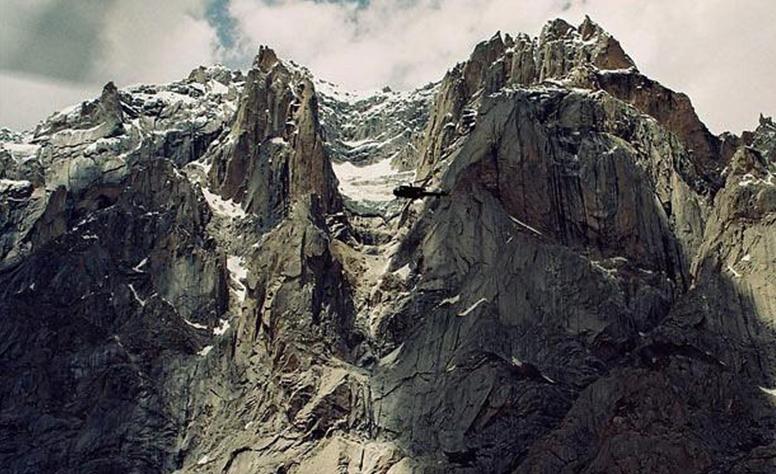 Pakistan must not make the same mistake that it made on Kashmir in 2004 when Musharraf regime chose unilateral ceasefire on LoC. This historical strategic blunder created two major problems for Pakistan. One of them is clearly existential in nature. First, Indians built a fence along the LoC bluntly violating the UN resolutions on Kashmir. Secondly, this allows Indians to put her anti-Pakistan hydrological war into top gear. Within two to three years, India would acquire the capability to block the Pakistani waters of 3 Western rivers which belong to Pakistan according to 1960 Indus Water treaty.
Pakistan must not make the same mistake that it made on Kashmir in 2004 when Musharraf regime chose unilateral ceasefire on LoC. This historical strategic blunder created two major problems for Pakistan. One of them is clearly existential in nature. First, Indians built a fence along the LoC bluntly violating the UN resolutions on Kashmir. Secondly, this allows Indians to put her anti-Pakistan hydrological war into top gear. Within two to three years, India would acquire the capability to block the Pakistani waters of 3 Western rivers which belong to Pakistan according to 1960 Indus Water treaty.
Likewise, it must be clear that once Pakistan Army begins moving down from the glacier, Indian army will start its Northwest march which Pakistan army has been blocking since 1984. India has spent billions of dollars on this battlefield and will never let her investment go in vein especially when the policymakers in Delhi are desperate to cut Pak-China road link via KKH.
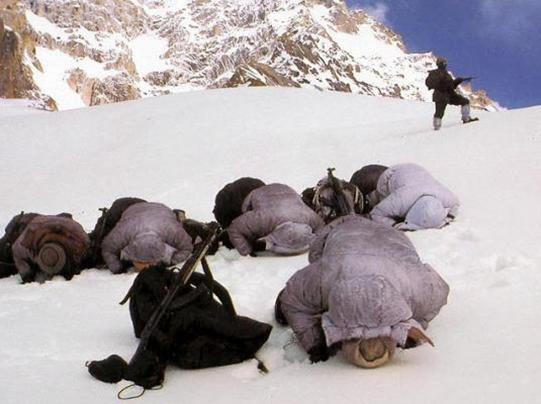 Infrastructure buildup by the Indians in the region is also a clear indicator about the Indian strategic thinking over this battlefield. Indians are building strategic tunnel and road networks to connect the Ladakh to other portions of the country. Roads in this area exist but current renovation and tunnel buildup is purely for military purposes. One such project is 9 KM long Rohtang Tunnel that will ensure all weather road connectivity between the Ladakh‟s capital Leh to Manali in Himachal Pradesh. It will be built at a height of 3,000-3,100 meters and one of the highest in the world. The tunnel is important to maintain supply lines to the forward posts in Ladakh and Siachen Glacier. [12]
Infrastructure buildup by the Indians in the region is also a clear indicator about the Indian strategic thinking over this battlefield. Indians are building strategic tunnel and road networks to connect the Ladakh to other portions of the country. Roads in this area exist but current renovation and tunnel buildup is purely for military purposes. One such project is 9 KM long Rohtang Tunnel that will ensure all weather road connectivity between the Ladakh‟s capital Leh to Manali in Himachal Pradesh. It will be built at a height of 3,000-3,100 meters and one of the highest in the world. The tunnel is important to maintain supply lines to the forward posts in Ladakh and Siachen Glacier. [12]
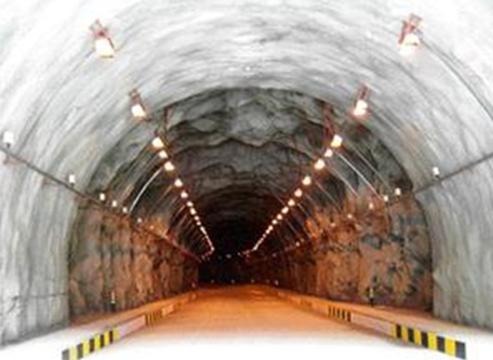 Rothang Tunnel – Part of Indian army’s strategic infrastructure Apart from that, Indian military preparedness regarding Siachen glacier clearly indicates that there is absolutely no sign from the Indian side to withdraw from world‟s highest battlefield and relocate them according to the 1989 agreement. Indian Army is taking deliveries of Dhruv helicopter which has specifically designed for icy regions. Dhruv passed these test trials in 2007[13] and is now part of Indian Army aviation.
Rothang Tunnel – Part of Indian army’s strategic infrastructure Apart from that, Indian military preparedness regarding Siachen glacier clearly indicates that there is absolutely no sign from the Indian side to withdraw from world‟s highest battlefield and relocate them according to the 1989 agreement. Indian Army is taking deliveries of Dhruv helicopter which has specifically designed for icy regions. Dhruv passed these test trials in 2007[13] and is now part of Indian Army aviation.
Indian Army upgraded Cheeta helicopters (under new name Cheetal) with more powerful engines back in 2006 to be used, by 114 Helicopter Unit, for logistical deliveries on Siachen glacier and Saltoro range peaks. According to Indian strategic analyst Dr Subhash Kapila, Siachen and Saltoro ridge are important for India due to following factors.
Strategic high ground and terrain domination over Pakistan’s Northern Areas and Shaksgam valley China. It blocks routes of ingress to the vital Ladakh sector, and provides a ‘strategic wedge’ to prevent a further Pakistan-China geographical link-up.
It acts as a ‘strategic pressure point’ against Pakistan’s military adventurism in the Kargil sector.
Indira-Col, the northern most part of Siachen, directly overlooks Chinese occupied territory that was illegally ceded by Pakistan to China. Having a foot on the ground here is the only way for India to legitimately and effectively dispute the illegal Chinese presence here. [14]
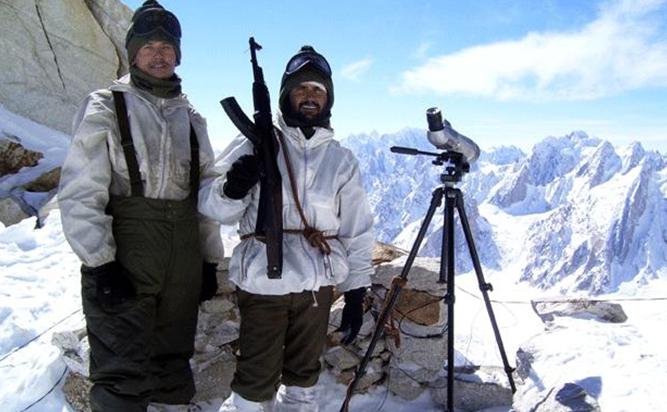 Indian Army Observation Post (OP) – Indian Army has built many such to look over Gilgat-Baltistan region and China Indian strategic community also considers Nubra Valley and Siachen glacier‟s Saser La pass as India’s best gateway to Central Asia. According to this thought process, when (not if) that pass is reopened for trade, the true strategic worth of defending Saltoro will become apparent even to the most willfully obtuse. [15]
Indian Army Observation Post (OP) – Indian Army has built many such to look over Gilgat-Baltistan region and China Indian strategic community also considers Nubra Valley and Siachen glacier‟s Saser La pass as India’s best gateway to Central Asia. According to this thought process, when (not if) that pass is reopened for trade, the true strategic worth of defending Saltoro will become apparent even to the most willfully obtuse. [15]
This clearly forewarns about the ultimate Indian design and accordingly India wants Pakistan to authenticate current position of both countries over this battlefield making the AGPL as permanent border between Pakistan and India. Pakistan must not ignore this thinking by Indian strategic community while evaluating its option on this front line. Like every other battlefield in the world, Siachen has its own share of critical lessons to be learned by Pakistan.
1. Pakistan would have been in much advantageous position had it adopted and matured the concept of building robust strategic lift capability as part of overall defense strategy which is crucial in offensive strategic maneuvers particularly in mountainous regions. Pakistan suffered in 1948, 1971 and 1984 as Indians had built and exploited this capability beating Pakistan Army in race to capture critical nodal points in war zones. Operation Maghdoot was essentially an airlift operation.
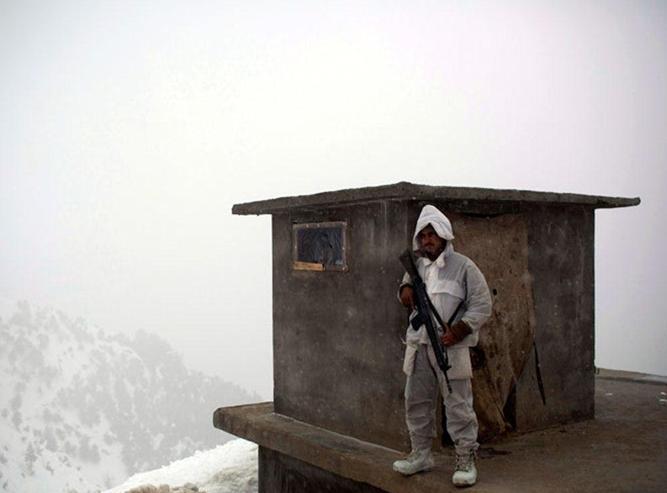 2. Strategic interests can only be secured from a position of strength in battlefield and it is true for diplomatic engagement as well. Accurate calculations like international reaction, diplomatic implications and geopolitical fallout’s must be made in the planning phase of any military maneuver. After all the war, on its own, is a political phenomenon with military power acting as a tool to achieve the position of strength in the end game.
2. Strategic interests can only be secured from a position of strength in battlefield and it is true for diplomatic engagement as well. Accurate calculations like international reaction, diplomatic implications and geopolitical fallout’s must be made in the planning phase of any military maneuver. After all the war, on its own, is a political phenomenon with military power acting as a tool to achieve the position of strength in the end game.
In Kargil war 1999, Pakistan was holding on to advantageous position by capturing high grounds but aftermath of war put Pakistani claim and credibility of being peaceful nation on shaky grounds and provided Indians with how-to-trust-Pakistan excuse making the diplomatic job more challenging for Pakistani foreign office.
Final Thoughts:
Pakistan made series of strategic miscalculations and mistakes on Kashmir issue during the last 2 decades and now there is no margin of error. The country is already in state of war against sub- conventional insurgencies and terrorism amid corruption, economic meltdown, ideological subversion, Indian media onslaught and historically worst governance. These facets of war have put Pakistan into a compromising position as exhibited by the decisions made over trade with India without demanding the solution for Kashmir. Indians being the main protagonist in Pakistan‟s existential war of survival are aware of the situation and want to get maximum concessions on each and every unresolved issue. Siachen is one of such core issues where
country‟s strategic interests are at stake and Gyari avalanche has provided the opportunity to the Indian elements within Pakistani media and civil society to push Indian foreign policy agenda. In present chaotic internal security situation, best option for Pakistan is to maintain the status quo on Siachen issue and pursue the settlement of the issue according to the bilateral agreements of 1949 and 1989 for demarcation of LoC and demilitarization of the glacier. Any backdoor diplomacy
over this critical battlefield would be suicidal and treacherous and Pakistani nation and armed forces would never accept another strategic blunder, not after giving countless ultimate sacrifices!
Pakistan Army Jawan – Standing alert on roof of the world to defend, to serve, to give ultimate sacrifice!
********************
End Notes
[1]Pakistan avalanche shines light on ‗futile‘ war, Washington Post, Published: April 8, 2012.
http://www.washingtontimes.com/news/2012/apr/9/pakistan-avalanche-shines-light-futile-
war/?page=2
[2] Demilitarization of the Siachen Conflict Zone: Concepts for Implementation and Monitoring
By Brigadier (ret.) Asad Hakeem Pakistan Army, Brigadier (ret.) Gurmeet Kanwal Indian Army
www.cmc.sandia.gov/cmc-papers/sand20075670.pdf
[3] An Interview with Padma Bhushan Lt Gen (Retd) Dr M.L Chibber,
http://www.defencejournal.com/2000/june/interview.htm
[4] Manning the Siachen Glacier BY Nikhil Shah, Sunil S and B. Bhattacharjee
http://www.bharat-rakshak.com/MONITOR/ISSUE6-1/Siachen.html
[5] The Coldest War By Kevin Fedarko*
21
http://www.wesjones.com/coldest.htm
[6] Ibid
[7] EXPEDITION FROM INDIA ARRIVES IN ANTARCTICA By Robert Reinhold Published: February 16, 1982
http://www.nytimes.com/1982/02/16/science/expedition-from-india-arrives-in-antarctica.html
[8] ―Saniha Siachen: Ae Puttar Hatan Tey Nahi Vikday‖ (Urdu) By Lt. Gen(retired) Abdul Qayyum Published: April 13, 2012
http://www.nawaiwaqt.com.pk/E-Paper/Lahore/2012-04-13/page-10
[9] All about the Siachen Glacier: the conflict, perspectives of India and Pakistan, geography, history and the possible resolutions
[10] Experiencing Siachen War ( Part 3) By: KEVIN FEDARKO
http://hassaanrabbani.wordpress.com/2011/09/08/experiencing-siachen-war-part-3-by-kevin-
fedarko/
[11] Getting real on Siachen BY AVM(Retired) Shahzad Chudhary Published April 18, 2012.
[12] Rohtang Tunnel to be completed by 2014 By Ritu Sharma published: 12/08/2009
[13] Dhruv all set to be inducted in Siachen sector, Hindustan Times Published September 03,
2007
http://www.hindustantimes.com/India-news/JAndK/Dhruv-all-set-to-be-inducted-in-Siachen-
sector/Article1-245931.aspx
[14] Don’t sell out Siachen By Dr Subhash Kapila Published: May 24, 2006
http://www.rediff.com/news/2006/may/24guest.htm
[15] Celebrating 20 years of victory on the Saltoro Ridge
http://forums.bharat-rakshak.com/viewtopic.php?f=14&t=118
Shahzad Masood Roomi is a lead research analyst at Brasstacks security think tank in Rawalpindi, Pakistan, and an assistant editor of monthly Brasstacks Security Review magazine, which presents a Pakistani prespective on regional and global strategic and political issues. Shahzad Masood Roomi area of expertise is military and strategics.
Windows to Russia!
The views of the above author are not strictly only the views of Windows to Russia. They are an independent view from an outside source that brings a better light on the world in general and Windows to Russia is very pleased to have Shahzad Masood Roomi’s thoughts on its pages today and in the future. So take a look at his references and read a few articles. – Kyle Keeton

